Where to go in Switzerland on a short trip: Alps, lakes, and cities
Switzerland is an extremely popular country for those planning multi-stop tours around Europe, yet very few potential first-time visitors actually know specifically where they want to go. Everyone seems to know that it has the most beautiful views of the Alps and some very impressive cities, but there are actually many misconceptions among casual trip planners, so I’d like to clear most of that up below. The places to visit in Switzerland are not obvious until you’ve been there yourself or done many hours of research, so the list below should be a short cut.
I get hundreds if not thousands of itinerary questions for people who are considering a Eurail trip around Europe, and most people just include the word “Switzerland” among a list of cities like Paris, Rome, and Berlin that they want to visit. So where in Switzerland should you go if you can only make a few stops at most? I’ll answer that question below. You’ll mostly want to focus on the best choices for Swiss Alps trips, which I’ll go over below.
Note: This article was expanded and updated in February, 2024.
Switzerland is about outdoor views rather than city visits
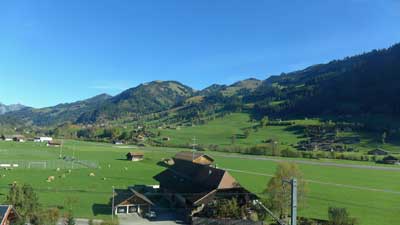
Geneva is a very famous city (though not for tourism reasons) on a lovely lake of the same name, but it’s also notoriously dull and lacking distinction. Rick Steves puts it well by saying that “Geneva is pleasantly situated on a lake, like Buffalo or Cleveland.” The point is, you don’t want to go to Geneva unless you’ve got something specific in mind that you want to see there. There are much better places to visit in Switzerland if your time is limited, or even if it’s not.
Switzerland's cities in summary
Zurich – The largest city, very expensive, geared towards business travelers. It’s generally a pretty and very well-run city that you would enjoy if you visited, but it’s not nearly as interesting as the likes of Vienna, Munich, or of course Paris.
Geneva – Second largest city, in the French part of the country, no major sights. Again, if you visited you’d be very impressed by it and get some great photos, but it’s not worth your time unless you know someone there. There’s an impressive fountain in the lake and you can usually see it from the train as you go through the city, but it’s not really worth going there and staying more than an hour or so.
Basel – Bordering France and Germany, no major sights. It has the famous art market each year, and aside from that it’s even duller than the ones above. Again, if you visited you’d be impressed, but if you later compared photos with friends who went to the Lauterbrunnen Valley instead, you’d kick yourself for going to Basel.
Lausanne – Near Geneva in the French part of the country, very hilly, and certainly more interesting than Geneva.
Bern – The capital, compact, on a lovely river, some interesting sights and the best Swiss city to get a feel for the culture. Bern is fairly close to Interlaken (which we will discuss below) and it can be a great day trip from there, especially on a day where it is foggy and/or rainy in the mountains (and this happens a LOT).
How much time and which Swiss cities to visit?
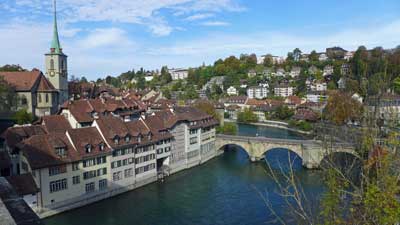
Many people (me included) don’t feel as if they’ve scratched the surface of a new country if they haven’t spent at least a day or two in the largest city. Zurich is certainly pleasant and a useful transit hub so spending one or two nights there wouldn’t be a major mistake. But Zurich isn’t even close to being a city like Paris, Rome, Berlin, Amsterdam, or even Vienna. If you skip it in favor of spending more time in the Swiss Alps, you won’t be missing much.
The 2 Best places to visit in Switzerland for short visits
Interlaken – If you want the best possible Alpine views and activities, head to the Interlaken area, which will be described in detail below. This is my favorite of all places to visit in Switzerland and it will probably be yours as well.
Lucerne – The traditional Swiss tourist retreat, Lucerne is a small city with interesting culture and sights, that is gorgeously set on a lake with plenty of top activities surrounding it.
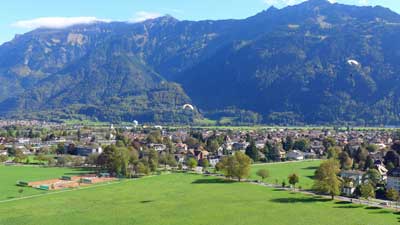
>>>Interlaken and Lucerne: Which to choose and how long to stay in each?
The article linked above will give you more details on which to choose and how long to spend in each place.
What about Zermatt for Alpine views?
Zermatt is a remote car-free village in southern Switzerland that is famous for being the place to see the Matterhorn mountain. It’s also a busy ski resort area, and aside from that, there isn’t much to see or do here. It’s on a private rail line, so it’s more complicated and usually more expensive to reach than Interlaken.
In other words, unless you’ve irrationally placed “Seeing the Matterhorn in person” on your so-called bucket list, skip Zermatt and head to Interlaken on a shorter visit. You won’t be sorry. If you already have enough time in your visit for the main sights around Interlaken and Lucerne and you want to also see the Matterhorn, then by all means go and you’ll enjoy it. There are quite a few other car-free villages in the Lauterbrunnen Valley near Interlaken, so they are not as novel in Switzerland as one might expect.
A weekend in Switzerland? What to see in 3 days
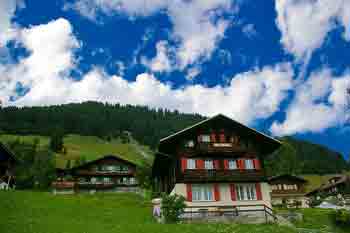
One challenge is that neither has an international airport so you’ll either be flying into Zurich or perhaps Geneva.
Train times from Zurich to Lucerne to Interlaken and back
- Zurich Airport to Lucerne: 1 hour 10 minutes by train
- Lucerne to Interlaken: 2 hours by train
- Interlaken to Zurich Airport: 2 hours 15 minutes by train
As you can see with the travel times above, Zurich Airport to Lucerne is a fairly short trip, but once you add Interlaken into the mix (even if you skip Lucerne) the travel time starts to add up for a weekend visit. With this in mind it’s probably best to just choose one of them and save the other one for another trip.
Lucerne is gorgeous, but the Lauterbrunnen Valley near Interlaken is really the star of the show, so I’d recommend going there first and doing Lucerne on another trip.
What about the Swiss Travel Pass?

The bottom line is that if you are coming to Switzerland for at least 3 days and you want to take 2 or more of the amazing scenic rail journeys that the country is famous for, the travel pass is probably a good deal. It also provides 50% discounts on the Schilthorn cable car and 25% off the Jungfraujoch mountain railway. Both of those are quite expensive on their own, but extremely worthwhile, so the discount is helpful.
The Half Fare Card is probably a better deal for most people
The Swiss Travel Pass is a good deal for those who are going to be spending at least 2 or 3 days riding the rails and seeing Switzerland that way. But if you are mostly going to be focusing on Interlaken and Lucerne and the mountain sights, the Half Fare Card is the best option. For CHF120 (about US$134) you get the card that is good for 30 days and gives you a 50% discount on all trains, cable cars, mountain railways, and other sights and attractions. If you are doing either Schilthorn or Jungfraujoch, the Half Fare Card practically pays for itself with just one of those.
>>>Buy the Swiss Half Fare Card
Many people have questions about the Swiss Half Fare Card so I will explain it a bit here. You can actually buy half price train tickets for travel within Switzerland any time you want and you will see that option when you go to buy them online. The only thing is you have to have and present a valid Half Fare Card when you get on the train and are asked to see your ticket. In other words, you can buy a half fare train ticket today and buy a Half Fare Card just before you get on that train months in the future, and you are fine.
How and why visit the area around Interlaken
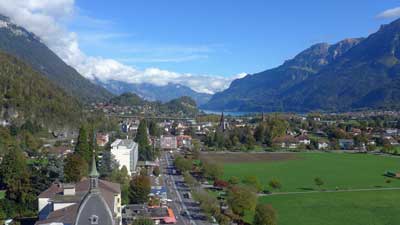
You can see everything discussed below by actually staying in a hotel in Interlaken, but it’s not the Alpine experience that you get if you stay in one of the small villages nearby. You can reach those villages in 20 to 40 minutes from the Interlaken Ost (East) train station, and it’s much easier than it sounds.
The 3 best places to stay to visit the Swiss Alps
Lauterbrunnen – A private train line runs from Interlaken Ost station to the end of its line in Lauterbrunnen. There’s a lovely waterfall here and great hiking trails, but you should probably only stay here if you can’t get to one of the villages mentioned just below. It’s a great little transit hub and it’s definitely gorgeous, so it can be worth a night if you’ve got one to spare.
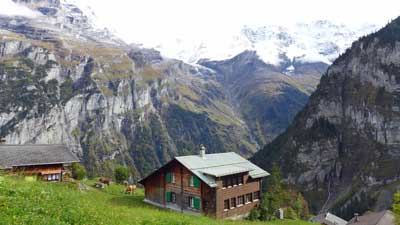
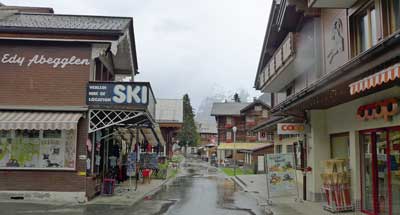
Where to stay in Interlaken and the Lauterbrunnen Valley (with pics)
I get so many questions about where to stay in the Interlaken area that I decided to write a longer version of it and load it with huge photos so readers can get a better feel for each option. I also included recommendations for affordable and well-located photos in each area.
>>>Where to stay in Interlaken and the Lauterbrunnen Valley New for 2024!
The unforgettable things to see here (if the weather is decent)
Schilthorn observation deck and restaurant
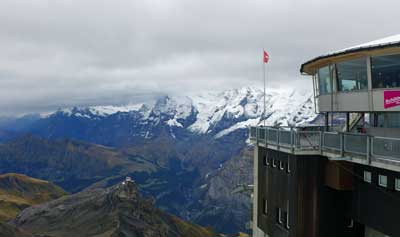
There is a rotating restaurant (with prices similar to normal Swiss restaurants) and a bizarre and anachronistic James Bond attraction based on it being a key location in the 1969 movie On Her Majesty’s Secret Service. The Bond thing is included with the lift, and it’s worth a look.
But the main thing you come here for is the 360-degree view from one of the highest peaks in Europe. Again, the weather here is key, but fortunately all the locals track the visibility on a minute-by-minute basis. If it’s clear up top while you are in the area, it would be a terrible shame to skip it based on the high price. But even if it’s cloudy up top, there are still plenty of wonderful things to see and do in the villages below.
Jungfraujoch observation area
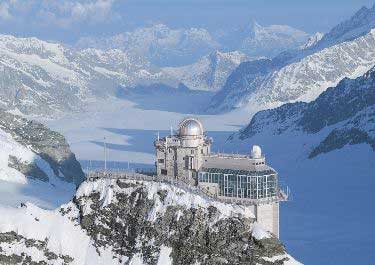
The views from the top are similar to the views from Schilthorn, from the other side of the Lauterbrunnen Valley. Once on top you can have lunch, hike, or even go sledding. It’s also quite expensive at nearly US$200 round-trip unless you have a Swiss Pass or a Eurail Pass for discounts, and it takes most of your day, but you’ll never forget the views from the top.
Harder Kulm mountain and Two Lakes Bridge Observation Deck
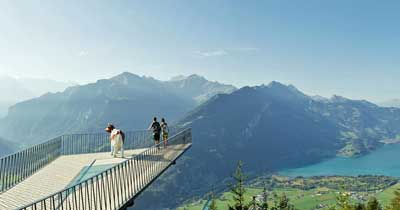
There’s a revolving restaurant about 10 minutes’ walk from the station at the top, which is definitely an unforgettable place for lunch if you’ve got time. It’s not as expensive as you might expect, at least compared to normal restaurants in Switzerland.
The Harder Kulm Railway goes from early April through late November each year. If you are only in Interlaken for one day and/or you are on a strict budget, this is the fastest and best way to get amazing Alpine views in the area.
Getting from Interlaken to Gimmelwald and Mürren
Getting up to these villages sounds complicated and time consuming, but it’s actually fast and easy once you get there. This little guide should help.
Arrive in Interlaken
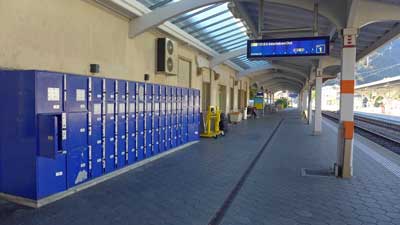
Once you arrive at the Interlaken Ost train station, head for the ticket windows in the office and buy a ticket to your final destination (Lauterbrunnen, Gimmelwald, or Mürren). Eurail passes are good for 25% discounts on the rest of the trip, but not for the whole thing.
From Interlaken Ost to Lauterbrunnen
The private train leaves Interlaken Ost every 30 minutes and arrives in Lauterbrunnen 20 minutes later. If you are staying in Lauterbrunnen then you are probably walking distance from your hotel when you reach the station.
From Lauterbrunnen to Gimmelwald
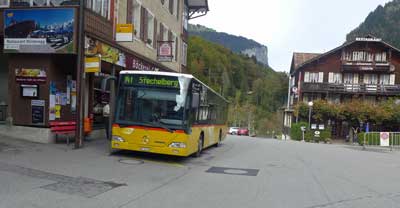

From
Gimmelwald to Mürren
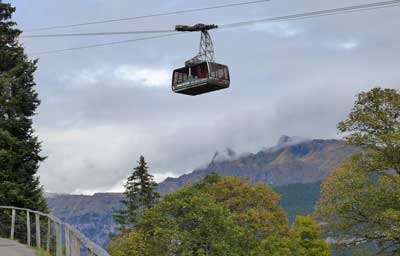
Recommended hotel and hostel in Gimmelwald
I get asked all the time about where to stay in Gimmelwald, so here it is:
Hotel: Esther’s Guesthouse
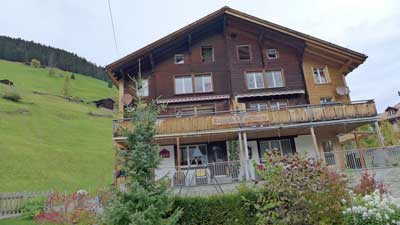
It’s run by Esther, as you might guess, and she is very friendly speaking excellent English. Each room is different and the place feels like a mountain cabin, because it is. She offers an excellent buffet breakfast in the morning, which you have to order the night before. It’s not cheap, but it’s worth it because it’s hearty and there are no other good options nearby.
Book as early as possible because this place is often the first place to sell out in Gimmelwald.
Hostel: Mountain Hostel Gimmelwald
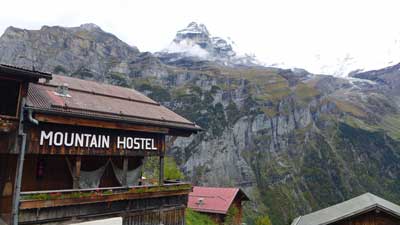
You won’t believe the views from this place, which are the same as from Esther’s except a bit lower and more unobstructed. This place also has a busy bar and restaurant that is basically the only “nightlife” in Gimmelwald. Many hikers get to bed early in this tiny village, but if you want to have a couple drinks and order a pizza or some local options, this is the place to go.
Again, book early because this place is always sold out.
Lucerne and what to do there
Luzern, as it’s spelled locally, is the other traditional holiday destination in Switzerland. Unlike Interlaken, Lucerne actually qualifies as a small city rather than a small resort town, so it’s a very nice contrast and very worthwhile. We have a new article with advice on where to stay in Lucerne and it should be helpful.
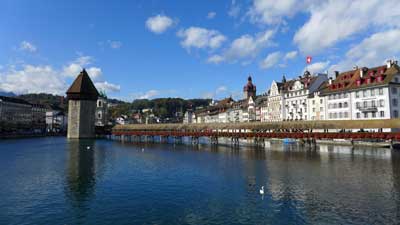
However, unlike Interlaken, the town of Lucerne itself is a great attraction and worth at least a day of exploration. This has always been a rich area so you can expect to find all of the high-end shops and boutiques along the small streets just north of the lake, but there are also many traditional shops and things to see that will appeal to anyone.
Recommended hotel in Lucerne
>>Hotel Des Alpes (3 stars with an amazing location and view)

If this place is booked, which is often the case, then book a hotel as close to it as you can find or afford. The whole historic part of town surrounding it is lovely, with restaurants, bars, and high-end shops. There are also a couple of nearby supermarkets where you can buy inexpensive alcohol and picnic supplies to keep other costs down.
Spend a day in Lucerne itself
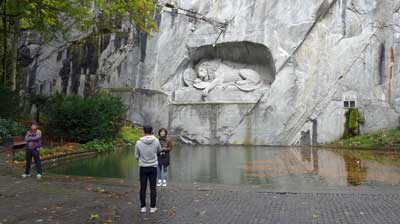
Most of the interesting part of Lucerne is in the area behind those restaurants, and it’s certainly worth doing a self-guided walking tour if not a guided one. Heading farther east you’ll come to another older part of town where the famous lion statue is located. You can’t visit Lucerne without having a look at the lion, and fortunately it’s easy and quick to reach (and it’s free).
Take a lake cruise of some kind
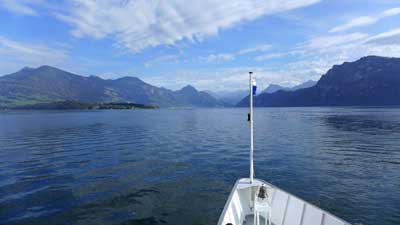
Especially in nice weather, even the short lake tour is lovely, and if you have more time you can jump off at Vitznau and do the scenic hike up Mount Rigi. There are also small lakeside villages that are ideal for a stroll and lunch stop. Long story short, there are dozens of interesting sightseeing options that are available using part of the boat tour, and the views all around are wonderful.
Visit Mount Pilatus
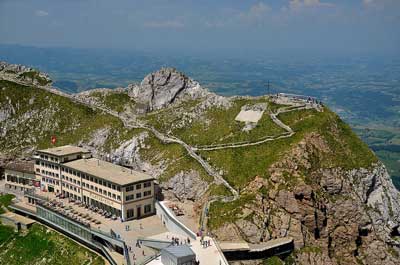
You can take the cogwheel train up and have a more or less flat hike around the summit area, and then take the gondola and cable car back down again. You can do them in the other order, and the cost is the same either way. At around US$65, this is not a cheap hike, but like most everything in Switzerland, the quality is high so it doesn’t feel like a rip-off. You can reach the cable car in 10 minutes on a public trolly bus from Lucerne.
Visit Mount Rigi
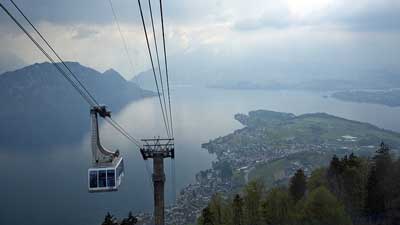
Unlike the other peaks mentioned in this article the Swiss Travel Pass covers both ways to get up and down for free. The others are 50% off with the Swiss Travel Pass or Half Fare Card, except for Jungfraujoch, which is only 25% off with the Swiss Travel Pass and still 50% off with the Half Fare Card.
Visit Mount Titlis
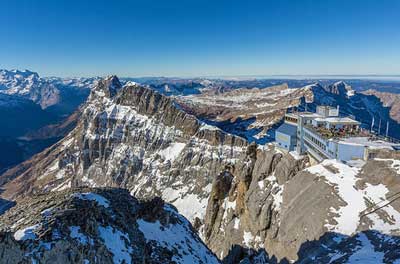
You can reach Titlis by taking a 43-minute train ride from Lucerne to Engelburg and then taking the cable car up from there. As with the others, it’s wise to check the weather immediately before you are going to depart because it can be foggy or cloudy any time of the year, but usually not for whole days at a time.
Additional photo credits
Jungfraujoch by cupweuro on Flickr, Pilatus by Tony Fernandez on Flickr, Rigi by Kosala Bandara on Flickr, Titlis by PaulSchliebs on Flickr

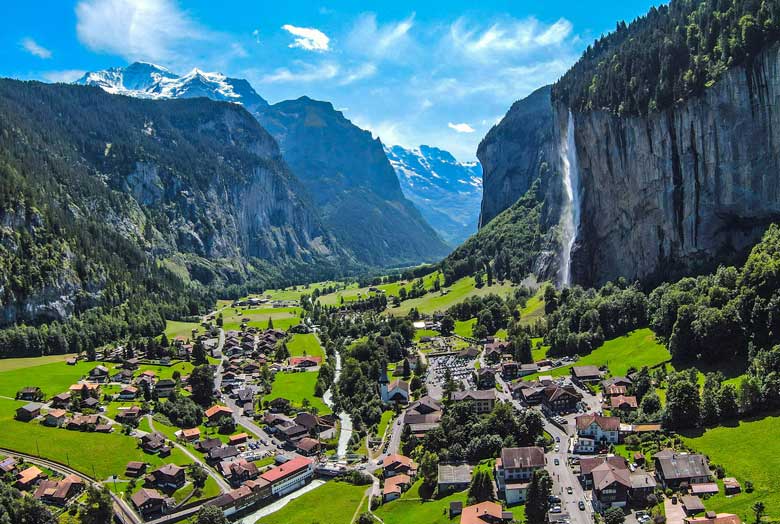
Thanks Roger. Its really helpful indeed.
I booked just now Esther’s for 2 nights. Cheers !!
Thanks Roger for the quick response.
As I look through staying options, I am getting following –
Seeking your personal advice here.
1- 2 night stay at Esther’s guesthouse as they don’t have stay for 1 night available . Mt. Hostel does not have private room facility. I am not finding any other good one.
2- 1 night stay in Murren instead of Gimmelwald in hotel Alpina and 1 night stay in Lauterbrunne or in city itself. Any specific suggestion.
Please suggest option more suitable and having more different experience in it.
Means is It still better in Gimmelwald as base for 2 days/2 nights to cover Jungfraujoch area on 2nd day and Murren/Schilthorn on 1st day.
3rd night, I have planned to stay in Lucerne.
Regards
Thanks in advance !!
Mayur,
I’d stay 2 nights at Esther’s Guesthouse, which is exactly what I did on my most recent visit. There is just something magical about staying in a tiny mountainside farming village like Gimmelwald that I will never forget. Murren has a similar setting, but it’s literally 50 times larger so it looks very different.
Since you’ll certainly have the Half Fare Card, that means that the cable car from Stechelberg to Gimmelwald (a 5-minute ride) will only cost about CHF2.50 each way, which is very cheap for the thrill of the ride itself. And you can leave Esther’s Guesthouse and be at the Lauterbrunnen train station in less than 20 minutes, so it’s really not much out of the way. Have a wonderful trip. -Roger
Hi Roger, Thanks for driving this detailed post. By reading, I tried to prepare below itenary (2 adults and a kid).
I would appreciate if you can validate below itinerary. Have full 4 days, 3 nights to spend.
1- 24th Aug, Reaching Basel at 21:50 PM, night stay
2- 25th Aug departs early morning to Interlaken Ost then Gimmelwald (Cover Murren and Schilthorn).Night stay @ Gimmelwald.
Since got full day, Some time of day might left to be utilized. Any suggestions ?
3– 26th morning, come back to Lauterbrunnen, take trip to Jungfraujoch. Stay Lauterbrunnen.
OR- 26th morning, come back to Lauterbrunnen, take trip to Jungfraujoch and come back Interlaken city by evening to one or 2 sights.Stay Interlaken.
OR its quite enough for a day so better to cover one or other (Jungfraujoch or Interlaken local attractions)
Which one to pick for stay(Interlaken or Lauterbrunnen) , Considering I will have to leave to Lucerne next day.
4 – 27th Morning, Leave for Lucerne, Visit the city, Lake Cruise. Night stay.
5 – 28th Morning, Day trip to Mount Pilatus reach back by 6 PM so I can get back to basel to catch my flight at 9:00 PM.
Is it time enought to cover Mount Pilatus by 6 PM, FI, I can start day early ?
Please correct any point of time.
Mayur,
I’ll answer the questions in order…
If you are starting the day in Basel, I think the train to Interlaken and then getting up to Schilthorn and back to Murren and then a walk to Gimmelwald will be a very full (and enjoyable) day. I wouldn’t add anything else as of now, and if you still have time when you get there you’ll find something interesting to do.
Jungfraujoch takes about 6 hours to get up, look around, and get back down. That leaves a few hours for a little walk around the area you are staying in, but again I don’t think I’d try to plan another major sight. The whole area is so beautiful that just strolling around the villages or along the paved hiking trails is lovely.
Interlaken is a large town and all of the others (Lauterbrunnen, Wengen etc) are small mountain villages. I think staying in one of the villages is nicer, and you’ll be entertained just walking around the area. But Interlaken obviously has far more restaurants and other things to do. It’s a tough call.
Mt Pilatus will take around 4 or 5 hours from the time you leave Lucerne until you are back again. So you should have plenty of time as long as you get an early start. Have a great trip. -Roger
Hi Roger,
Many thanks for a wonderful blog and your patience and kind efforts to help all.
We family of 2 adults and 2 children (12- 13 years) are planning to travel to France – Annecy – Wengen – Florence – Rome for 10 nights during mid-August. Have made arrangement for airtickets and hotel bookings for France 3 nights, Annecy 1 night, Wengen 3 nights, Florence 1 night and Rome 2 nights.
Got stuck on the train bookings and need your kind guidance wherever possible on the following train bookings and for best travel passes for:
1. Travel from Paris CDG by train to Annecy. Overnight stay at Annecy.
2. Travel from Annecy to Wengen by train. Stay in Wengen for 3-4 nights. Wish to do sightseeing around Wengen i.e., especially Interlaken, Jungfraujoch, Mt. Titlis and around including cable cars. Any other sight please recommend if possible in 3 -4 days including above.
3. Travel from Wengen to Florence by train.
4. Travel from Florence to Rome by train.
Shall be grateful if you can kindly guide us by providing details of train bookings best routes and travel passes to help us book the same for an economical and a time saving journey.
Thanks and kind regards,
Sant
Sant,
Wengen is just a little hill village in the Interlaken area, so you’ll be close enough to anything in Interlaken for activities from there. Schilthorn and Jungfraujoch (both mentioned in the article above) are the two marquee viewpoints in the area, but there are countless others.
The main transit hub in Interlaken is the Interlaken Ost (east) train station. From there you get a private train to Lauterbrunnen and then another short ride to Wengen (all covered by the Half Fare Card). To get from Interlaken to Florence the fastest way is to book a train to Milan. It will include a short ride from Interlaken Ost to Spiez, and then a fast train to Milan. From Milan you change trains for one that goes to Florence. You should be able to buy the whole ticket from Interlaken Ost to Florence on either the Swiss Rail or Italian Rail websites. From Wengen to Interlaken Ost it’s just two short train rides that don’t require reservations and leave every 30 minutes.
Let me know if you have any other questions. -Roger
Hi Roger,
Thank you so much for taking the pain to answer my queries. And you really need not apologise. I am sorry for badgering you with questions.
So, I somewhat have an itinerary in mind and have mentioned my questions with each day below. Sorry for the details again. I know I am being very cautious and meticulous while planning.
Day 1: Reach our Hotel in Emmen (which is a small village around Lucerne) by 10/11 AM. Take the boat cruise and some strolling around Emmen.
Question 1 – Will the boat cruise be covered by the half fare card? Do I need to book this in advance online or can I just go purchase on arrival at Lucerne?
Question2 – I would ideally like to hop on / off and stop by for a few walks around. What cruise would you suggest?
Day2: Half day visit to Mt Pilatus. I searched and got some info on this – The top can be reached with the Pilatus Railway, from Alpnachstad, and back via aerial panorama gondolas and aerial cableways from Kriens. Is this correct?
Question 1: Is it the same boat cruise that also takes one to Alpnachstad? In that case, I can club Boat Cruise and Mt Pilatus on Day 2 itself.
Question 2: or skip Mt Pilatus and go to Zermatt instead?
Day 3: Spend time in Lucerne during the morning hours, catch some attractions and go to Bern for a city feel for the rest of the day.
Day 4: We move to Interlaken early morning. Do the Gimmelwald and Murren day trip. I would like to spend some time in Lauterbrunnen and walk through the town seeing some waterfalls. Question 1 – Will that be possible? If I do make a stop, will I be able to get onto that bus outside the station later?
Day 5: Wander around Interlaken. I read about a chocolate making class in the town market, may be do that and Lake Thun. I need more help with this day. May be Obwalden or Zermatt or Wengen? I am not up for steep hikes because of my back problem. Need paved hikes for sure.
Question – Should I split Lauterbrunnen walk and stop with this day instead of covering it the day before?
Question on the travel card-
Seeing that 95% I am going to the above places with flexibility to change the dates, is the half fare card better? I saw some rail lines by numbers, some termed as “R” and some termed as “IC”. Does that mean the lines to Obwalden and Zermatt will have private companies and not covered by the travel card or pass?
Aparna,
I’ll tackle your questions in order…
1. Yes, the boat cruise and almost every other form of transportation and sightseeing in Switzerland is covered by the Half Fare Card.
2. The main 2-hour cruise leaving from the Lucerne dock across from the train station allows you to hop off and back on at each of the small villages it stops at. Another one will come along every 30 to 60 minutes during the day.
DAY 2
1. No, the main Lucerne cruise does not go to Alpnachstad. It’s a different boat that leaves from the same dock.
2. Zermatt is nice, but it’s a long way out of the way to get there and back. I’d do the Pilatus peak since you are already right there.
DAY 4
The bus from Lauterbrunnen to the Stechelberg cable car station passes the waterfall. I think you can get off the bus and then on the next one, but I’m not sure. You get a pretty good view of the waterfall just on the bus.
DAY 5
I’m not a good source for details on every hike in the area, but I can tell you that there is no shortage of great hikes, and many of them are flat or downhill if you take a train or cable car up and walk down. Many (but not all) are paved as well. Lauterbrunnen is a small town and I don’t think it’s as scenic as Murren, Gimmelwald, Wengen, or Grindelwald.
The Half Fare Card covers a 50% discount on ALL of those train rides. The Swiss Travel Pass covers most of the normal intercity (IC) trains, but it only offers a 50% discount on most of the private railways, such as the one to Zermatt. I can’t keep track of all of them, but generally I think the HFC is a better deal for most travelers unless they are planning at least two of the longer scenic trains. -Roger
Hi Roger – Great article and appreciate your patience! I did choose Murren based on your reco for trip in end-August 2017.
Which hike did you do instead of the Jungfrau train (as per one of you responses above)? Which hikes would you recommend in the region if we are a young couple with a demanding 2 year old (sometimes on pram and sometimes on back)? Can we bike down the mountains with the 2 year old (at low speed) tightly fastened?
Nipun,
I did a few hikes in the area, but the one that stands out the most is one that starts from the cable car station just above Wengen. I found it described well here, with photos as well. I did it in summer so it was easier.
I wouldn’t recommend that one pushing a pram because most of it isn’t paved and some of it is uneven. There are other hikes in the area that are paved, however, including the ones down from Murren to Gimmelwald and several others from Murren. I’m not really a hiking expert and I’m sure there is better info somewhere else with maps and more detailed information on terrain and such. Best of luck with this. -Roger
Roger-
Thank you very much for response. Will surely get back to you if something required.
Roger
Thanks for your response. Have few queries before finalizing the itinerary .
As mentioned we have sufficient time left .
Any night life in Gimmelwald or better to move Interlaken after returning from Jungfraujoch ?
Are there any other things to do at Murren before walking down to Gimmelwald ?
I also had a look at the Half Fare Card will it be useful ?
We are planning to visit Paris. Please let me know which would be the fastest route to reach Paris.
Interlakne-Zurich-Paris or Interlakne-Bern-Paris or any other options ?
Jdy,
Interestingly enough, Gimmelwald is this tiny farming village so you wouldn’t expect any nightlife at all. But the Mountain Hostel, which is right next to the cable car stop in the middle of town, has a lively bar that brings most of the interesting visitors in town together every night. They also serve very good pizza. Nothing there is cheap, but that’s true all over Switzerland.
As for Murren it’s a much larger village and there are plenty of shops and various hiking trails that go up and down from the main path. The whole area is so stunning to witness that you might not need more formal activities.
The Half Fare Card, which I discuss at length in my article about the Swiss Travel Pass, is a good value for almost every visitor to Switzerland. The only people it’s NOT good value for are people who are taking at least 2 or 3 of the long scenic train rides, and the Swiss Travel Pass is better. And for people who are ONLY taking a train in and then later a train out without any cable cars or mountain activities, you might not save enough to make the CHF120 worth it. But if you are going to be taking the trains and cable cars around Lauterbrunnen then getting to that CHF120 mark for the Half Fare Card can happen in just a day or two.
To get to Paris from Interlaken the fastest train takes 5 hours 30 minutes or so and requires a train change in Basel. If you buy a Half Fare Card you can use it to save 50% on the train from Interlaken to Basel. And then buy a separate ticket from Basel SBB (the main station in Switzerland) to Paris Gare de Lyon. The Swiss trains are notoriously punctual so you can take any train that leaves at least 15 minutes after you are scheduled to arrive in Basel. Basel is a pretty dull city, but still you might want to walk around the center for a bit before getting on your train to Paris. Buy your ticket from Basel to Paris on the official France rail site as early as possible for the lowest fares. Let me know if you have any other questions. -Roger
Thank you again for your response. One more question. Should we purchase Swiss Pass or Euro Rail pass? Which one would make more sense?
Thank you,
Olga
Thank you so much for your reply Roger! We’ll definitely try to take a train on the way there!
Olga